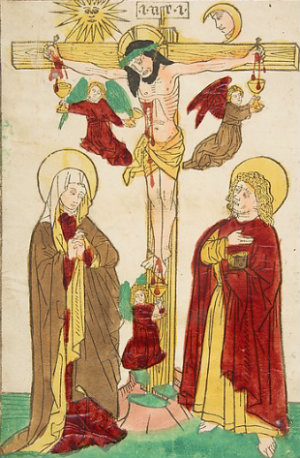Search:: Artists Alphabetically Artists by Country Artists by Century Artists by Movement
The Cross
The meaning of the cross used
in Byzantine, Gothic and Renaissance Painting. Byzantine, Gothic and Early Renaissance
paintings are rich in philosophical and Christian symbolism regarding
The Cross
The Cross is a very ancient symbol The history of this powerful icon is ambiguous. The cross was used centuries before appearance of Christ . The cross can be found in Egyptian and Assyrian sculptures, carvings and paintings. There are many different explanations and legends about the original meaning of this sacred symbol. If you spend a good deal of time rooting around the Holy lands you are sure to have many different interpretations. Often academic and scholarly sources contradict each other. According to Anna Jameson, author of Sacred and Legendary Art, "About the tenth century the Fish disappeared, and the Cross symbol of our redemption from the apostolic times became the sole and universal emblem of the Christian faith. The cross placed in the hand of a saint is usually the Latin cross, the form ascribed to the cross on which our Saviour suffered."
The cross first
appeared in Christian art on a Vatican sarcophagus ( A
wood, clay or metal coffin) from the 450
AD. To early Christian it is clear that the cross symbolized
the manner of death of Jesus Christ and His sufferings
subsequent death, and as a symbol of His sacrifice.
It is the most important Christian Holy Symbol. The Latin Inverted Cross - represents the
Martyrdom of St. Peter, also known as the St. Peter cross. St Peter was
crucified on an upside down cross because he didn't feel himself worthy
to be crucified on the same kind of cross as the Messiah, Jesus Christ.

Key Descriptive Words and Phrases associated with the Renaissance Movement - rebirth, rediscovery of the classical world, City-state, Humanism, Humanist, Francesco Petrarch, Reform, The Prince, Theocracy, The Inquisition, Human Reasoning, publication of Della Pittura, a book about the laws of mathematical perspective for artists, sfumato, chiaroscuro, linear perspective, Heliocentric Theory, vanishing point, Savonarola, spiritually significant, illuminated manuscript, idealized biblical themes, scriptorium, emotion, illuminator, Age of Discovery, axonometric drawing, curiosity about the natural world, mythology, realistic use of colours and light, Bonfire of the Vanities, Old Testament stories, ethereal and foggy backgrounds, Gospel parables, The Blackdeath, romanticized landscapes, Christian symbolism.
☼☼☼☼☼
Require more facts and information about the painter and the artists of the cross? Poke around every nook and cranny of the known universe for information this subject. Search Here
© HistoryofPainters.com If you like this page and wish to share it, you are welcome to link to it, with our thanks.